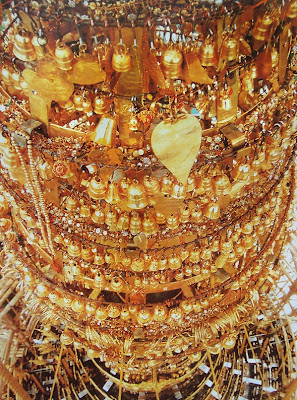Pagoda bells are somehow like their counterparts in the church.
but they give their melody when people bang on them unlike they do in the church this is much more easy, impressive and won't make noise.
The story of its great bells is an integral part of the history of this widely famed Buddhist shrine. A 32 ton bronze and brass bell donated by the Mon King Dhammazedi was stolen by the Portuguese adventurer Philip de Brito y Nicote in 1608. This mercenary, a former ship's cabin boy had declared himself King of Lower Burma and established his capital at Thanlyin (Siriam) just across the Yangon River.
He intended to melt down this late 15th Century bell to make cannons, but the bell was lost forever in the murky waters of the Yangon River when the boat transporting it and other plundered loot capsized.
He intended to melt down this late 15th Century bell to make cannons, but the bell was lost forever in the murky waters of the Yangon River when the boat transporting it and other plundered loot capsized.
A massive earthquake demolished the top of the Shwedagon in 1768.
After King Hsinbyushin of the Konbaung dynasty (1752 -1885) renovated it, raising the height of the stupa to its present 326 feet during the process. His son, King Singu, had the 23 ton Maha Tissada Ganda bronze bell cast between 1775 and 1779 and placed on the north-west side of the main pagoda platform.
 |
| The Maha Tissada Pagoda Bell at the Shwedagon Pagoda platform in Yangon |
During the first Anglo - Burma war (1824 - 1826) the British attempted to pilfer the bell and convey it to Calcutta but history repeated itself and the bell fell into the river. The British made many attempts to recover the very heavy weight from its watery abode but failed. The Burmese proposed to raise the heavy thing stipulating that it be returned to its original location in the pagoda.
The British readily agreed since they had a poor opinion of the Burmese astuteness. Putting into operation an ingenious and effective plan, native divers descended to the bottom of the river, fastened innumerable bamboo poles underneath the heavy bell until it slowly floated to the surface.
All large shrines have many of various sizes including the very small golden ones at the top producing the melody when the wind moves them, most of them engraved with praises for the Lord and some with hopeful wishes of the donor. They are placed everywhere on the precinct. In addition to the ones on the ground, the hti (umbrella) contains a large number of small golden bells.
Most have inscriptions arranged in horizontal rows in Pali or Burmese.
Sometimes almost the whole surface of the bell is covered with characters; it is usually to the dedications of the people who have donated the bell. These dedications are either about the hope to reach the ideal state of enlightenment, or they include preserving the Nats requests to the earth, the air and the house, the cultivated fields and the family from misfortune and evil powers. Also appeals to the attainment of Nirvana in one of the coming rebirths are occasionally included in such bell inscriptions.
Usually Myanmar bells hung not high, rather close the ground. There is no clapper; with a thicker baton, a wooden rod the bell is beaten to mark the attention of the deity in honor of their good work, said a prayer, a sacrifice or the like completed. Due to the resonance body they have different sound. Even with fingers one can cause an elongated delicate and harmonious tone. When the first one was casted is still unclear, however they were already in use in the times of the kingdom of Bagan.
One of the most famous Mingun Bell near Mandalay, placed at the
unfinished gigantic brick stupa at in 1790. This is located near Mandalay at
the other side of the Irrawaddy River in Sagaing Division. The height including
the loop for hanging up amounts to 7 m, weight 90 tons. It’s the second biggest
in the world after the Moscow Tsar Bell.
A nationwide famous is in a special Tazaung.
The bell has the name
Maha Ganda which means
melodious voice . Casted in 1775-1779, has a weight of 23.3 tons and a
height of 3.5 m (without strap) . A particularly sophisticated and artfully
decorating has the loop in the form of a sculpture composition depicting dragons
and Nats. Another one is located in a tazaung
shows the name of King Tharawadi of 1841 and her name is also Maha Tissada
Ganda, a very solid piece with approximately 2 m, it has a 30.5 cm thick wall
and weighs 42 tons. The decor underlines the massifs and the severity of that
bell.
- Buddhist Stupa
- Buddhist Temples
- Mandalay Pagodas
- Monywa Pagoda
- Mrauk U Pagoda
- Myanmar Pagoda
- Stupas and Temples





And we always thought we invented the bells for sacred purposes. well it is not.
ReplyDelete